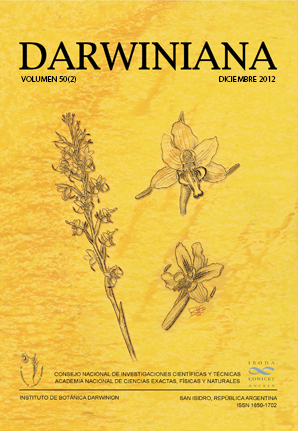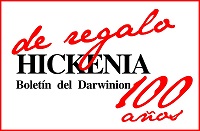CARTOGRAFÍA DE LA VEGETACIÓN DE LA ISLA DE BIOKO (GUINEA ECUATORIAL) MEDIANTE EL USO DE IMÁGENES LANDSAT 7 ETM+: PARTICULARIZACIÓN DEL PISO AFROMONTANO
DOI:
https://doi.org/10.14522/darwiniana.2014.502.433Palabras clave:
África, cartografía forestal, imágenes satelitales, Prunus, teledetección, tipos de vegetación, vegetación afromontanaResumen
La gestión forestal sostenible requiere de una información cartográfica adecuada. En este trabajose elaboró una cartografía actual de la vegetación de la isla de Bioko (Guinea Ecuatorial) basada en laclasificación supervisada de una imagen Landsat 7 ETM+, y una cartografía de la vegetación del pisoafromontano, que incluye datos de la distribución, la superficie y los tipos forestales con presencia de Prunus africana. Se proponen seis nuevos tipos de vegetación de transición entre los bosques Guineo-Congolesa y los bosques afromontanos, y distintas formaciones afromontanas secundarias. El mapa devegetación de Bioko tuvo un coeficiente Kappa de 0,69. Los principales errores se asociaron a las clasescorrespondientes a bosque secundarios de tierras bajas y a las zonas de transición entre los bosques congolesesy afromontanos. La fiabilidad del análisis mejoró en una segunda clasificación restringida a lavegetación afromontana de la isla (> 1400 m s.m.), obteniéndose un coeficiente Kappa de 0,81. En estetrabajo se muestra la utilidad de la teledetección para la elaboración de cartografía en zonas tropicalesde escasa accesibilidad, dado que se obtuvieron resultados con una fiabilidad adecuada para la gestiónforestal.
Descargas
Publicado
Cómo citar
Número
Sección
Licencia

A partir de 2012, esta obra está licenciada bajo una Licencia Creative Commons Atribución-NoComercial 2.5 Argentina .
Cualquier obra derivada deberá estar previamente autorizada con nota escrita de los editores.







